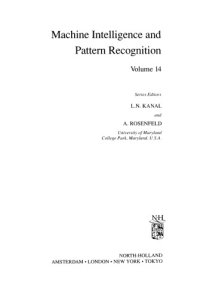
Ebook: Parallel processing for artificial intelligence
Author: Laveen N Kanal
- Series: Machine Intelligence and Pattern Recognition 14
- Year: 1994
- Publisher: North-Holland
- City: Amsterdam ; New York
- Language: English
- pdf
Parallel processing for A1 problems is of great current interest because of its potential for alleviating the computational demands of Al procedures. The articles in this book consider parallel processing for problems in several areas of artificial intelligence: image processing, knowledge representation in semantic networks, production rules, mechanisation of logic, constraint satisfaction, parsing of natural language, data filtering and data mining. The publication is divided into six sections. The first addresses parallel computing for processing and understanding, images. The second discusses parallel processing for semantic networks, which are widely used means for representing knowledge - methods which enable efficient and flexible processing of semantic networks are expected to have high utility for building large-scale knowledge-based systems. The third section explores the automatic parallel execution of production systems, which are used extensively in building rule-based expert systems - systems containing large numbers of rules are slow to execute and can significantly benefit from automatic parallel execution. The exploitation of parallelism for the mechanisation of logic is dealt with in the fourth section. While sequential control aspects pose problems for the parallelization of production systems,. logic has a purely declarative interpretation which does not demand a particular evaluation strategy. In this area, therefore, very large search spaces provide significant potential for parallelism. In particular, this is true for automated theorem proving. The fifth section considers the problem of constraint satisfaction, which is a useful abstraction of a number of important problems in Al and other fields of computer science. It also discusses the technique of consistent labelling as a preprocessing step in the constraint satisfaction problem. Section Vi consists of two articles, each on a different, important topic. The first discusses parallel formulation for the Tree Adjoining Grammar (TAG), which is a powerful formalism for describing natural languages. The second examines the suitability of a parallel programming paradigm called Linda, for solving problems in artificial intelligence. Each of the areas discussed in the book holds many open problems, but 't is believed that parallel processing will form a key ingredient in achieving at least partial solutions. It is hoped that the contributions, sourced from experts around the world, will inspire readers to take on these challenging areas of inquiry
Download the book Parallel processing for artificial intelligence for free or read online
Continue reading on any device:

Last viewed books
Related books
{related-news}
Comments (0)